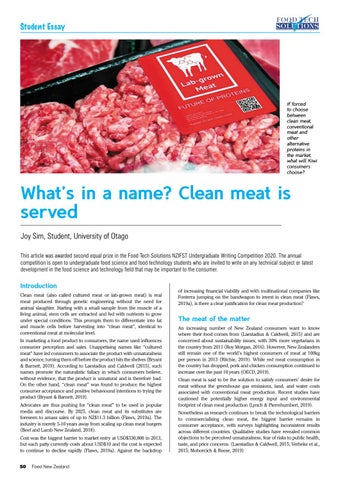Student Essay
If forced to choose between clean meat, conventional meat and other alternative proteins in the market, what will Kiwi consumers choose?
What’s in a name? Clean meat is served Joy Sim, Student, University of Otago This article was awarded second equal prize in the Food Tech Solutions NZIFST Undergraduate Writing Competition 2020. The annual competition is open to undergraduate food science and food technology students who are invited to write on any technical subject or latest development in the food science and technology field that may be important to the consumer.
Introduction Clean meat (also called cultured meat or lab-grown meat) is real meat produced through genetic engineering without the need for animal slaughter. Starting with a small sample from the muscle of a living animal, stem cells are extracted and fed with nutrients to grow under special conditions. This prompts them to differentiate into fat and muscle cells before harvesting into “clean meat”, identical to conventional meat at molecular level. In marketing a food product to consumers, the name used influences consumer perception and sales. Unappetising names like “cultured meat” have led consumers to associate the product with unnaturalness and science, turning them off before the product hits the shelves (Bryant & Barnett, 2019). According to Laestadius and Caldwell (2015), such names promote the naturalistic fallacy in which consumers believe, without evidence, that the product is unnatural and is therefore bad. On the other hand, “clean meat” was found to produce the highest consumer acceptance and positive behavioural intentions to trying the product (Bryant & Barnett, 2019). Advocates are thus pushing for “clean meat” to be used in popular media and discourse. By 2025, clean meat and its substitutes are foreseen to amass sales of up to NZ$11.3 billion (Flaws, 2019a). The industry is merely 5-10 years away from scaling up clean meat burgers (Beef and Lamb New Zealand, 2018). Cost was the biggest barrier to market entry at USD$330,000 in 2013, but each patty currently costs about USD$10 and the cost is expected to continue to decline rapidly (Flaws, 2019a). Against the backdrop 50
Food New Zealand
of increasing financial viability and with multinational companies like Fonterra jumping on the bandwagon to invest in clean meat (Flaws, 2019a), is there a clear justification for clean meat production?
The meat of the matter An increasing number of New Zealand consumers want to know where their food comes from (Laestadius & Caldwell, 2015) and are concerned about sustainability issues, with 30% more vegetarians in the country from 2011 (Roy Morgan, 2016). However, New Zealanders still remain one of the world’s highest consumers of meat at 100kg per person in 2013 (Ritchie, 2019). While red meat consumption in the country has dropped, pork and chicken consumption continued to increase over the past 10 years (OECD, 2019). Clean meat is said to be the solution to satisfy consumers’ desire for meat without the greenhouse gas emissions, land, and water costs associated with conventional meat production. Recent studies have cautioned the potentially higher energy input and environmental footprint of clean meat production (Lynch & Pierrehumbert, 2019). Nonetheless as research continues to break the technological barriers to commercialising clean meat, the biggest barrier remains in consumer acceptance, with surveys highlighting inconsistent results across different countries. Qualitative studies have revealed common objections to be perceived unnaturalness, fear of risks to public health, taste, and price concerns. (Laestadius & Caldwell, 2015; Verbeke et al., 2015; Mohorcich & Reese, 2019)
